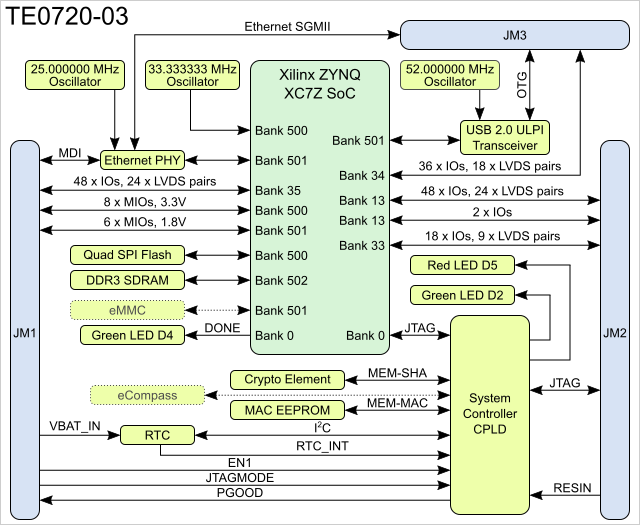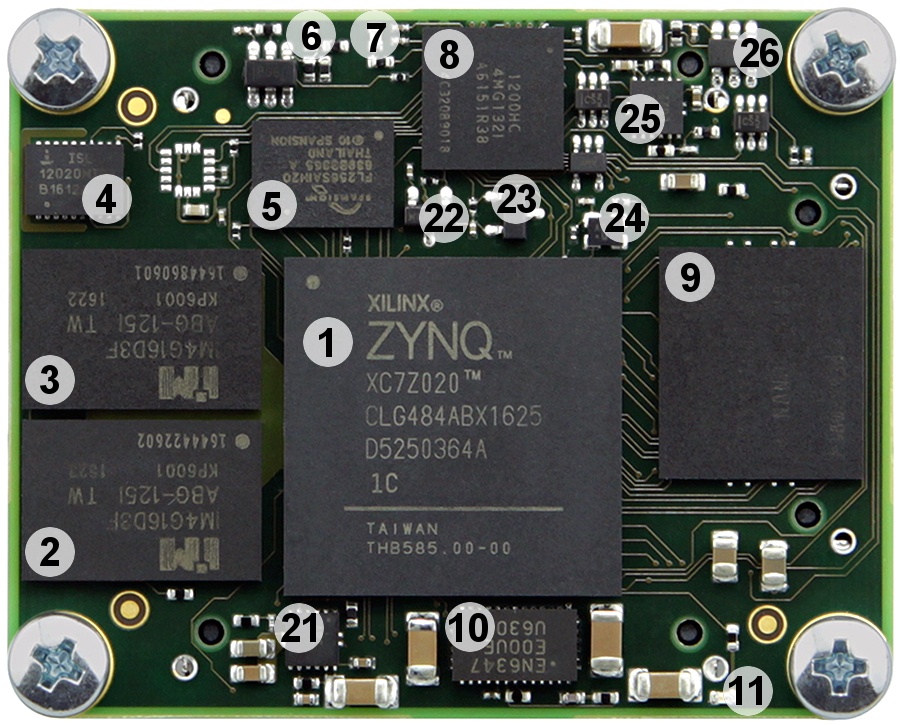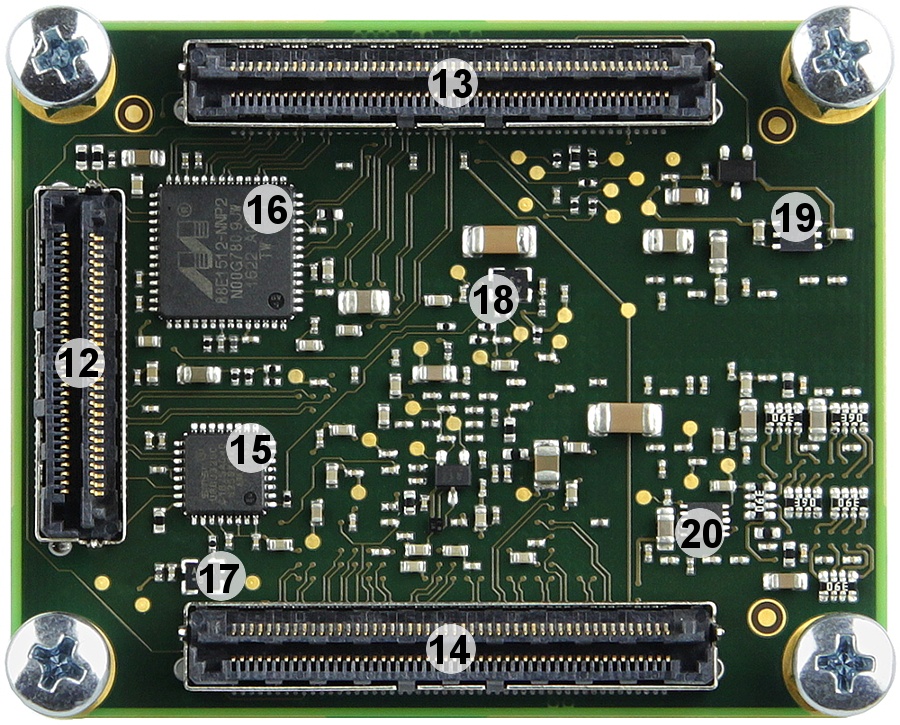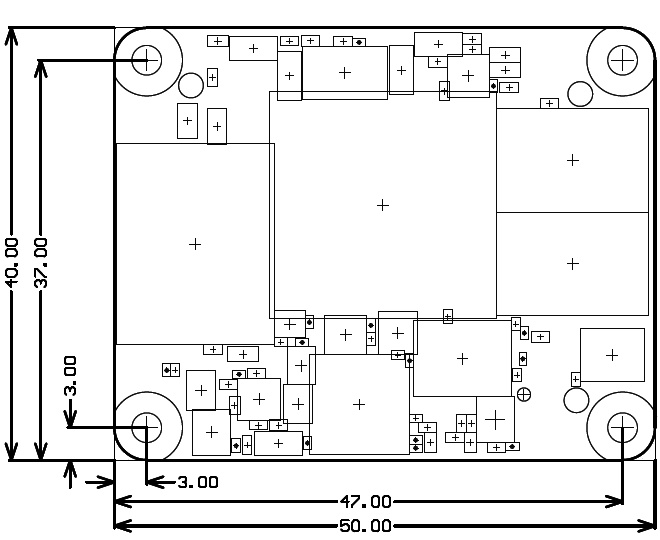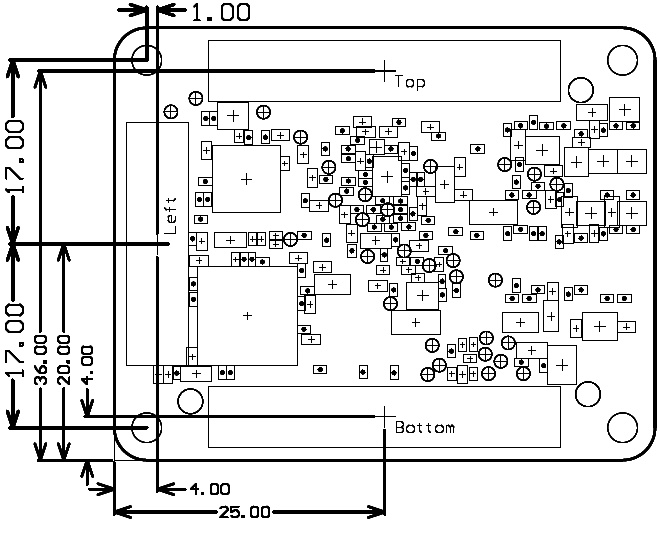Page History
| Scroll Ignore |
|---|
Download PDF Version version of this Documentdocument. |
| Scroll pdf ignore | ||||
|---|---|---|---|---|
Table of Contents
|
Overview
| Scroll Only (inline) |
|---|
Refer to https://shopwiki.trenz-electronic.de/dedisplay/Download/?path=Trenz_Electronic/PD/TE0715+TRM for downloadableonline version of this manual and additional technical documentation of the product. |
The Trenz Electronic ... TE0720 is an industrial-grade ... based on ...
Block diagram
Put your block diagram here...
Main components
Put top and bottom pics with labels of the real PCB here...
Add description list of PCB labels here...
Key features
List key features here, like FPGA type, amount and type of RAM, type of flash, etc.
SoM (System on Module) based on Xilinx Zynq-7000 SoC (XC7Z020) with up to 1 GB of DDR3/L SDRAM, 32MB of SPI flash memory, Gigabit Ethernet PHY transceiver, a USB PHY transceiver and powerful switching-mode power supplies for all on-board voltages. A large number of configurable I/Os is provided via rugged high-speed stacking strips. See also Variants Currently in Production section.
Key Features
- Xilinx XC7Z SoC (XC7Z020)
- Processing System: Dual ARM Cortex-A9
Unified 512 KByte L2 cache
256 KByte on-chip memory
54 multiplexed I/O pins (MIOs)
- Programmable Logic: Artix-7 FPGA
85 K logic cells
560 KByte extensible block RAM (140x 36 Kbit BRAM blocks)
220 programmable DSP slices
Dual 12-bit 1Msps AD converter
200 I/O pins (SelectIO interfaces) - System Controller CPLD (Lattice LCMXO2-1200HC)
- 1 GByte DDR3/L memory, 2 x 256 Mbit x 16 (32-bit wide)
- 32 MByte Quad SPI Flash memory
- Gigabit Ethernet transceiver PHY (Marvell 88E1512)
- Highly Integrated full-featured hi-speed USB 2.0 ULPI transceiver (Microchip USB3320C-EZK)
- 3-axis accelerometer and 3-axis magnetometer (ST Microelectronics LSM303DTR) (Not installed!)
- Real time clock with embedded crystal (Intersil ISL12020M): ±5ppm accuracy
- Up to 32 GByte eMMC, usually 4 GByte, depends on module variant and assembly option
- User LED 1 (Green), user LED 2 (Red), user LED 3 - FPGA DONE (Green)
- 1.5A, PowerSoC DC-DC step-down converter (Enpirion EP53F8QI) for 1.8V power supply
- 1.5A, PowerSoC DC-DC step-down converter (Enpirion EP53F8QI) for 1.5V power supply
- 4A PowerSoC DC-DC step-down converter (Enpirion EN6347) for 1.0V power supply
- Trenz 4 x 5 module socket connector (3 x Samtec LSHM series connectors)
...
Additional assembly options are available for cost or performance optimization upon request.
| Page break |
|---|
Block Diagram
Components and connections marked with dashed lines are optional or may be missing on some module variants, please contact us for additional information.
Main Components
- Xilinx Zynq XC7Z SoC, U5
- 4 Gbit DDR3/L SDRAM, U13
- 4 Gbit DDR3/L SDRAM, U12
- Low-power RTC with battery backed SRAM, U20
- 32 MByte Quad SPI Flash memory, U7
- Red LED (LED1), D5
- Green LED (LED2), D2
- System Controller CPLD, U19
- eMMC NAND Flash, U15
- 4A high-efficiency PowerSoC DC-DC step-down Converter (1V), U1
- Green LED (DONE), D4
- B2B connector Samtec Razor Beam™ LSHM-130, JM3
- B2B connector Samtec Razor Beam™ LSHM-150, JM1
- B2B connector Samtec Razor Beam™ LSHM-150, JM2
- Hi-speed USB 2.0 ULPI transceiver, U18
- Gigabit Ethernet (GbE) transceiver, U8
- Low-power programmable oscillator @ 52.000000 MHz (OTG-RCLK), U14
- Low-power programmable oscillator @ 33.333333 MHz (PS-CLK), U6
- Low-dropout regulator (VBATT), U24
- DDR termination regulator, U4
- 1.5A PowerSoC DC-DC step-down converter with integrated inductor (1.5V), U2
- Atmel CryptoAuthentication chip, U10
- 2Kbit UNI/O® serial EEPROM with EUI-48™ node identity, U17
- Low-power programmable oscillator @ 25.000000 MHz (ETH-CLK), U9
- 1.5A PowerSoC DC-DC step-down converter with integrated inductor (1.8V), U3
- 3A PFET load switch with configurable slew rate (3.3V), Q1
Initial Delivery State
Storage device name | IC | Content | Notes |
|---|
Quad SPI Flash | U7 | Empty | - |
| eMMC NAND Flash | U15 | Empty | - |
| 11AA02E48T EEPROM | U17 | Pre-programmed globally unique, 48-bit node address (MAC) | - |
| System Controller CPLD | U19 | Standard firmware. | Download firmware |
Signals, Interfaces and Pins
Board to Board (B2B) I/
...
Os
I/O signals connected to the SoC's I/O IO bank and B2B connector:
| Bank | Type | B2B Connector | I/O Signal Count | Voltage | Notes |
|---|---|---|---|---|---|
| 13 | GPIO | JM2 | 48 I/Os, 24 LVDS pairs | VCCIO13 | |
| 13 | GPIO | JM2 | 2 I/Os | VCCIO13 | B13_IO0 and B13_IO25 |
| 33 | GPIO | JM2 | 18 I/Os, 9 LVDS pairs | VCCIO33 | |
| 34 | GPIO | JM3 | 36 I/Os, 18 LVDS pairs | VCCIO34 | |
| 35 | GPIO | JM1 | 48 I/Os, 24 LVDS pairs | VCCIO35 | |
| 500 | MIO | JM1 | 8 MIOs | 3.3V | |
| 501 | MIO | JM1 | 6 MIOs | 1.8V |
For detailed information about the pin-out, please refer to the Pin-out Tables. tables.
JTAG Interface
JTAG access to the Xilinx Zynq and to the System Controller CPLD is provided through B2B connector JM2.
JTAG Signal | B2B Connector Pin |
|---|---|
| TMS | JM2-93 |
| TDI | JM2-95 |
| TDO | JM2-97 |
| TCK | JM2-99 |
| Note |
|---|
| JTAGMODE pin 89 in B2B connector JM1 is used to select which device is accessible. Low - Xilinx Zynq, High - System Controller CPLD. |
| Page break |
|---|
System Controller I/O Pins
Special purpose pins are connected to System Controller CPLD and have following default configuration:
| Pin Name | Mode | Function | Default Configuration |
|---|---|---|---|
| RESIN | Input | Reset input | Active low reset input, default mapping forces POR_B reset to Zynq PS. |
| PGOOD | Output | Power good | Active high when all on-module power supplies are working properly. |
| MODE | Input | Boot mode | Force low for boot from the SD card. Latched at power-on only, not during soft reset! |
| EN1 | Input | Power enable | High enables the DC-DC converters and on-board supplies. Not used if NOSEQ is high. |
| NOSEQ | Input | Power sequencing | Forces the 1.0V and 1.8V DC-DC converters always ON when high. |
| JTAGMODE | Input | JTAG select | Keep low for FPGA JTAG access. |
On-board LEDs
| LED | Color | Connected to | Description and Notes |
|---|---|---|---|
| D2 | Green | LED1 | Controlled by System Controller CPLD firmware. |
| D4 | Green | DONE | |
| D5 | Red | LED2 | Controlled by System Controller CPLD firmware. |
Clocking
| Clock Signal | Frequency | IC | FPGA | Notes |
|---|---|---|---|---|
PS-CLK | 33.333333 MHz | U6 | PS_CLK_500 | PS subsystem main clock. |
OTG-RCLK | 52.000000 MHz | U14 | - | USB3320C reference clock. |
| ETH-CLK | 25.000000 MHz | U9 | - | 88E1512 reference clock. |
| Page break |
|---|
Default MIO Mapping
| MIO | Function | B2B Pin | Notes | MIO | Function | B2B Pin | Notes | |
|---|---|---|---|---|---|---|---|---|
| 0 | GPIO | JM1-87 | - | 16..27 | ETH0 | - | RGMII | |
| 1 | QSPI0 | - | SPI-CS | 28..39 | USB0 | - | ULPI | |
| 2 | QSPI0 | - | SPI-DQ0 | 40 | SD0 | JM1-27 | B2B | |
| 3 | QSPI0 | - | SPI-DQ1 | 41 | SD0 | JM1-25 | B2B | |
| 4 | QSPI0 | - | SPI-DQ2 | 42 | SD0 | JM1-23 | B2B | |
| 5 | QSPI0 | - | SPI-DQ3 | 43 | SD0 | JM1-21 | B2B | |
| 6 | QSPI0 | - | SPI-SCK | 44 | SD0 | JM1-19 | B2B | |
| 7 | GPIO | - | SC CPLD pin P11 | 45 | SD0 | JM1-17 | B2B | |
| 8 | - | - | 3.3V | 46 | SD1 | - | MMC-D0 | |
| 9 | - | JM1-91 | B2B | 47 | SD1 | - | MMC-CMD | |
| 10 | - | JM1-95 | B2B | 48 | SD1 | - | MMC-CLK | |
| 11 | - | JM1-93 | B2B | 49 | SD1 | - | MMC-D1 | |
| 12 | - | JM1-99 | B2B | 50 | SD1 | - | MMC-D2 | |
| 13 | - | JM1-97 | B2B | 51 | SD1 | - | MMC-D3 | |
| 14 | - | JM1-92 | B2B | 52 | ETH0 | - | MDC | |
| 15 | - | JM1-85 | B2B | 53 | ETH0 | - | MDIO |
| Page break |
|---|
Gigabit Ethernet
On-board Gigabit Ethernet PHY is provided with Marvell Alaska 88E1512 IC (U8). The Ethernet PHY RGMII interface is connected to the Zynq Ethernet0 PS GEM0. I/O voltage is fixed at 1.8V for HSTL signalling. SGMII (SFP copper or fiber) can be used directly with the Ethernet PHY, as the SGMII pins are available on the B2B connector JM3. The reference clock input of the PHY is supplied from an on-board 25.000000 MHz oscillator (U9), the 125MHz output clock signal CLK_125MHZ is connected to the pin G13 of the System Controller CPLD chip (U19).
Ethernet PHY connection
| PHY Pin | Zynq PS | PL | Notes | Notes | ||||
|---|---|---|---|---|---|---|---|---|
| MDC | MIO52 | Routed to System Controller CPLD pin L14. | ||||||
| MDIO | MIO53 | Routed to System Controller CPLD pin K14. | ||||||
| LED0 | - | Routed to System Controller CPLD pin F14. | ||||||
| LED1 | - | Routed to System Controller CPLD pin D12. | ||||||
| LED2/Interrupt | - | Routed to System Controller CPLD pin C13. | ||||||
| CONFIG | - | Routed to System Controller CPLD pin C14. | ||||||
| RESETn | MIO50 | - | ||||||
| RGMII | MIO16..MIO27 | - | ||||||
| SGMII | - | Routed to B2B connector JM3. | ||||||
| MDI | - | Routed to B2B connector JM1. |
| Page break |
|---|
USB Interface
USB PHY is provided with ...by USB3320 from Microchip. The ULPI interface is connected to the Zynq PS USB0 via MIO28..39, bank 501. The I/O voltage is fixed at 1.8V and reference clock input of the PHY is supplied from the on-board 52.000000 MHz oscillator (U14).
USB PHY connection
| USB PHY Pin | ZYNQ Pin | SC CPLD |
|---|
| Pin | B2B Name | Notes | ||
|---|---|---|---|---|
| REFCLK | - | - | - | 52.000000 MHz reference clock from on-board oscillator (U14). |
| REFSEL0..2 | - | - | - | Reference clock frequency select, all set to GND selects 52.000000 MHz. |
| RESETB | - | B14, bank 1 | - | Active low reset. |
| CLKOUT | MIO36 | - | - | ULPI output clock mode. |
| DP, DM | - | OTG-D_P, OTG-D_N | USB data lines. | |
| CPEN | - |
| VBUS_V_EN | External USB power switch active high enable signal. | |||
| VBUS | - | - | USB-VBUS | Connect to USB VBUS via a series of resistors, see reference schematics. |
| ID | - | - | OTG-ID | For A-device connect to the ground, for B-device leave floating. |
| SPK_L | - | M5, bank 2 | - | In USB audio mode a switch connects the DM pin to the SPK_L pin. |
| SPK_R | - | M8, bank 2 | - | In USB audio mode a switch connects the DP pin to the SPK_R pin. |
The schematics for the USB connector and required components is different depending on the USB usage. USB standard A or B connectors can be used for Host host or Device device modes. A Mini mini-USB connector can be used for USB Device device mode. A micro-USB Micro connector can be used for Device device mode, OTG Mode mode or Host Modehost mode.
I2C Interface
On-board I2C I2C devices are connected to MIO.. and MIO.. which are configured as I2C... by default. I2C addresses for on-board devices the System Controller CPLD, device slave addresses are listed in the table below:
| I2C Device | I2C Address | IC | I2C Device | I2C Adress | Notes |
|---|---|---|---|---|---|
| ISL12020M RTC | 0x6F |
JTAG Interface
JTAG access to the ... is provided through B2B connector ....
...
JTAG Signal
...
B2B Connector Pin
...
| Note |
|---|
| JTAGEN pin in B2B connector ... should be kept low or grounded for normal operation. |
System Controller I/O Pins
Special purpose pins are connected to smaller System Controller CPLD and have following default configuration:
...
| U20 | RTC registers. | ||
| ISL12020M SRAM | 0x57 | U20 | Battery backed RAM in RTC IC. |
| LSM303D | 0x1D | U22 | Optional, not soldered on current production variants. |
Boot Process
By default the TE-0720
Boot Modes
By default the ... supports QSPI and SD Card boot modes which is controlled by the MODE input signal from the B2B JM1 connector.
MODE Signal State | Boot Mode |
|---|---|
high High or open | SD Card |
low Low or connected to the ground | QSPI |
LED's
...
On-board Peripherals
Processing System (PS) Peripherals
| Name | IC | ID | PS7 | MIO Bank | MIO | Notes |
|---|
Clocking
...
PS CLK
...
33.3333 Mhz
...
...
PS_CLK
...
PS subsystem main clock.
...
GT REFCLK1
...
125 Mhz
...
...
| Gigabit Ethernet | 88E1512 | U8 | ETH0 | 501 | MIO16..27 MIO52..53 | MIO52 and MIO53 are also connected to the System Controller CPLD. |
| USB OTG | USB3320C | U18 | USB0 | 501 | MIO28..39 | |
| SPI Flash | S25FL256SAGBHI20 | U7 | QSPI0 | 500 | MIO1..6 | |
| eMMC Flash | MTFC4GMVEA-4M IT1) | U15 | SD1 | 501 | MIO46..51 |
1) Different make and model may be installed on different module variants.
RTC - Real Time Clock
An temperature compensated ... compensated Intersil ISL12020M is used for Real Time Clock (U20). Battery voltage must be supplied to the module from the baseboard. .
PLL - Phase-Locked Loop
There is a I2C programmable clock generator ... chip on the ...
PLL connection
...
Battery backed registers can be accessed over I2C bus at slave address of 0x6F. General purpose RAM is at I2C slave address 0x57. RTC IC is supported by Linux so it can be used as hwclock device.
MAC-Address EEPROM
A ... Microchip 2Kbit 11AA02E48 serial EEPROM (U..U17) is used which contains a connected to the System Controller CPLD and contains globally unique 48-bit node address , that which is compatible with EUI-48(TM) and EUI-64(TM) specificationTM specification. Upper 1/4 of the memory array contains 48-bit node address and is write protected.
Power and Power-On
...
Sequence
Power Supply
Power supply with minimum current capability of ...A 3A for system startup is recommended.
Power Consumption
| Power Input Pin | Max Typical Current |
|---|---|
| VIN | TBD* |
| 3.3VIN | TBD* |
* TBD - To Be Determined soon with reference design setup.
Power-On Sequence
For highest efficiency of the on-board DC/-DC regulators, it is recommended to use same 3.3V power source for both VIN and 3.3VIN power rails.
Power Rails
...
Voltages on B2B-
Connectors
...
B2B
...
B2B
...
B2B
...
Input/
Output
...
Although VIN and 3.3VIN can be powered up in any order, it is recommended to power them up simultaneously.
It is important that all baseboard I/Os are 3-stated at power-on until System Controller CPLD sets PGOOD signal high (B2B connector JM1, pin 30), or 3.3V is present on B2B connector JM2 pins 10 and 12, meaning that all on-module voltages have become stable and module is properly powered up.
See also Xilinx datasheet DS187 for additional information. User should also check related baseboard documentation when choosing baseboard design for TE0720 module.
Power Rails
B2B Name | B2B JM1 Pins | B2B JM2 Pins | Direction | Note |
|---|---|---|---|---|
| VIN | 1, 3, 5 | 2, 4, 6, 8 | Input | Supply voltage from baseboard. |
| 3.3VIN | 13, 15 | 91 | Input | Supply voltage from baseboard. JM2-91 is VREF_JTAG. |
| VCCIO35 | 9, 11 | - | Input | High range bank voltage from baseboard. |
| VCCIO33 | - | 5 | Input | High range bank voltage from baseboard. |
| VCCIO13 | - | 7, 9 | Input | High range bank voltage from baseboard. |
| VCCIO34 | - | 1, 3 | Input | High range bank voltage from baseboard. |
| VBAT_IN | 79 | - | Input | RTC battery-buffer supply voltage. |
| 3.3V | - | 10, 12 | Output | Internal 3.3V voltage level. |
| 1.8V | 39 | - | Output | Internal 1.8V voltage level. |
| 1.5V 1) | - | 19 | Output | Internal 1.5V voltage level. |
1) In case of module variant of TE0720-03-L1IF which uses Xilinx Zynq XC7Z020-L1CLG484I chip with lower power consumption, power rails named 1.5V and VCCO_DDR_502 voltage is actually 1.35V. To achieve this, a resistor with different value is used for R4 (see schematics of the TE0720-03-L1IF for more information).
...
Bank Voltages
Bank |
|---|
| Schematics Name | Voltage |
|---|
TE0715-xx-15
TE0715-xx-30
Board to Board Connectors
... put some B2B related information here if you have them ...
...
| Notes | |||
|---|---|---|---|
| 500 | 3.3V, VCCO_MIO0_500 | 3.3V | |
| 501 | 1.8V, VCCO_MIO1_501 | 1.8V | |
| 502 | 1.5V, VCCO_DDR_502 | 1.5V | |
| 0 Config | 3.3V | 3.3V | |
| 13 HR | VCCO13 | 1.2V to 3.3V | Supplied by the baseboard. |
| 33 HR | VCCIO33 | 1.2V to 3.3V | Supplied by the baseboard. |
| 34 HR | VCCIO34 | 1.2V to 3.3V | Supplied by the baseboard. |
| 35 HR | VCCIO35 | 1.2V to 3.3V | Supplied by the baseboard. |
Board to Board Connectors
| Include Page | ||||
|---|---|---|---|---|
|
Variants Currently in Production
| Module Variant | Zynq SoC | RAM | eMMC Size | Temperature Range | B2B Connector Height |
|---|---|---|---|---|---|
| TE0720-03-2IF | XC7Z020-2CLG484I | 1 GByte | 4 GByte | Industrial | 4.0 mm |
| TE0720-03-2IFC3 | XC7Z020-2CLG484I | 1 GByte | 4 GByte | Industrial | 2.5 mm |
| TE0720-03-2IFC8 | XC7Z020-2CLG484I | 1 GByte | 32 GByte | Industrial | 4.0 mm |
| TE0720-03-L1IF | XC7Z020-L1CLG484I | 512 MByte | 4 GByte | Industrial | 4.0 mm |
| TE0720-03-1CF | XC7Z020-1CLG484C | 1 GByte | 4 GByte | Commercial | 4.0 mm |
| TE0720-03-1CR | XC7Z020-1CLG484C | 256 MByte | - | Commercial | 4.0 mm |
| TE0720-03-14S-1C | XC7Z014S-1CLG484C | 1 GByte | 4 GByte | Commercial | 4.0 mm |
| TE0720-03-1QF | XA7Z020-1CLG484Q | 1 GByte | 4 GByte | Automotive | 4.0 mm |
Technical Specifications
Absolute Maximum Ratings
Parameter | Min | Max | Units | Reference Document |
|---|---|---|---|---|
VIN supply voltage |
V
Storage temperature
-40
+85
°C
Recommended Operating Conditions
| -0.3 | 6.5 | V | EP53F8QI datasheet. | |
| 3.3VIN supply voltage | -0.1 | 3.75 | V | TPS27082L and LCMXO2-1200HC datasheets. |
| Supply voltage for PS MIO banks | -0.5 | 3.6 | V | See Xilinx DS187 datasheet. |
| I/O input voltage for MIO banks | -0.4 | VCCO_MIO + 0.55 | V | See Xilinx DS187 datasheet. (VCCO_MIO0_500, VCCO_MIO1_501) |
| Supply voltage for HR I/Os banks | -0.5 | 3.6 | V | See Xilinx DS187 datasheet. (VCCIO13, VCCIO33, VCCIO34, VCCIO35) |
| I/O input voltage for HR I/O banks | -0.4 | VCCIO + 0.55 | V | See Xilinx DS187 datasheet. |
Storage temperature | -40 | +85 | °C | - |
| Storage temperature without the ISL12020MIRZ, eMMC Flash and 88E1512 PHY installed | -55 | +100 | °C | NB! Module variants using Nanya SDRAM chips, max temperature limit is +125 °C. |
| Note |
|---|
| Assembly variants for higher storage temperature range are available on request. |
Physical Dimensions
Module size: ... mm × ... mm. Please download the assembly diagram for exact numbers.
Mating height with standard connectors: ... mm.
PCB thickness: ... mm.
Highest part on PCB: approx. ... mm. Please download the step model for exact numbers.
All dimensions are given in mm.
| Note |
|---|
| Please check Xilinx datasheet DS187 for complete list of absolute maximum and recommended operating ratings. |
Recommended Operating Conditions
| Parameter | Min | Max | Units | Reference Document |
|---|---|---|---|---|
| VIN supply voltage | 2.5 | 5.5 | V | EN6347QI and EP53F8QI datasheets. |
| 3.3VIN supply voltage | 3.135 | 3.465 | V | 3.3V +/- 5%. |
| Supply voltage for PS MIO banks | 1.71 | 3.465 | V | See Xilinx DS187 datasheet. |
| I/O input voltage for PS MIO banks | -0.20 | VCCO_MIO + 0.20 | V | See Xilinx DS187 datasheet. |
| Supply voltage for HR I/Os banks | 1.14 | 3.465 | V | See Xilinx DS187 datasheet. |
| I/O input voltage for HR I/O banks | -0.20 | VCCIO + 0.20 | V | See Xilinx DS187 datasheet. |
...
Operating Temperature Ranges
Commercial grade: 0°C to +70°C.
Industrial and automotive grade: -40°C to +85°C.
Operating temperature range depends also on customer design and cooling solution. Please contact us for options.
Weight
... g - Plain ...
Physical Dimensions
Module size: 50 mm × 40 mm. Please download the assembly diagram for exact numbers.
Mating height with standard connectors: 8 mm.
PCB thickness: 1.6 mm.
Highest part on PCB: approx. 2.5 mm. Please download the step model for exact numbers.
All dimensions are given in millimeters.
Weight
ca 23 g - Plain module... g - Set of bolts and nuts
Revision History
Hardware Revision History
Hardware revision number is printed on the PCB board together with the module model number separated by the dash.
Put pic of PCB silk screen here showing model and revision ...
Document Change History
Date | Revision | Contributors | Description |
|---|---|---|---|
| 20162017-1106-3001 | Jan Kumann | Initial Documentdocument. |
Disclaimer
| Include Page | ||||
|---|---|---|---|---|
|
